|
|
|
[GENUS CYPERUS]
|
. |
|
. |
|
19a
|
( 17) 17)
|
Plant a soft (spongy), green, vertical stem (a culm) lacking leaf blades, although basal sheaths without blades may be present and leaf-like bracts directly under the inflorescence may be present near the top of the culm. { Wetland species (FACW and OBL) .. .
|
|
[20]
|
|
|
19b
|
|
Leaf blades (other than involucral bracts) present. Culm clasped by one or more long, narrow leaves (leaves are cauline, attached at points up the culm) OR with a basal rosette of narrow leaves OR with cauline and basal leaves. { Wetland and upland species .. .
|
|
[23]
|
|
~~~~ ~~~~~~~~~~~~~~~~~~~~~~~~~
|
|
20a
|
( 11 11
&
19)
|
Large to very large plants, rising from 3 to as much as 15 ft (1 to 5 m) in height. Culms weakly trigonous, from 1/2 to 1 in (1 to 3 cm) in diameter near the base, and terminated by many unequal, arching branches, these each with 3 to 8 secondary branches. Leaf blades absent or (rarely) very short, clasping base of culm. { An ornamental sedge, escaping and naturalizing by offshoots (seeds apparently not produced in Hawai‘i). Egyptian papyrus [HAW - NAT] [GUM - NAT] [OBL]
|
|
|
|
20b
|
|
Small to large plants, culms generally under 4 ft (1.5 m) in height and under 1/2 in (1 cm) in diameter at the base. Leaf sheaths present, but lacking blades. Culms terminated by flowering spikes, sessile or on short branches, and leafy involucral bracts, which are longer or shorter than the inflorescence (if few, one may appear as an extension of the culm giving appearance that inflorescence is not terminal; see Fig. 32C) .. .
|
|
[21] |
|
~~~~ ~~~~~~~~~~~~~~~~~~~~~~~~~
|
|
21a
|
(20) |
Involucral bracts mostly shorter than inflorescence; OR spikelets sessile on culm with but only one long bract, this extending vertically above the spikelet cluster .. .
|
|
[22] |
|
21b
|
|
Involucral bracts linear, typically long, and 3 or more present .. .
|
|
[35] |
|
~~~~ ~~~~~~~~~~~~~~~~~~~~~~~~~
|
|
22a
|
(21)
|
Culms terminated by 50 to 250 rays (branches), superficially resembling the head of a papyrus sedge; however, these branches support clusters of reddish-brown spikelets. Bladeless, dark (reddish brown to purple) leaf sheaths clasp base of weakly trigonous culms that rise between 1 to 3 ft (0.3 to 1.1 m) in height. { An ornamental sedge grown in water gardens, naturalized on Kaua‘i. Dwarf papyrus [HAW - NAT] [OBL]
|
|
|
22b
|
|
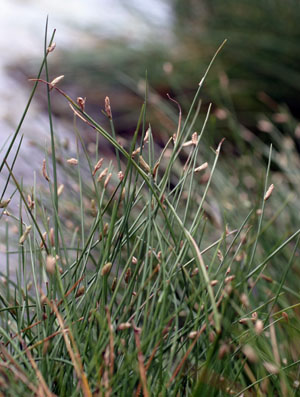 Spikelets sessile and terminal on the culm, from 3 to 30 in number, subtended by several bracts, the longest being rolled and vertical, appearing as a continuation of the culm above the flower head. Culms three-sided. { Plants small to large, 6 in to 3 ft (0.2 - 1 m) in height. Makaloa [HAW - IND] [OBL] 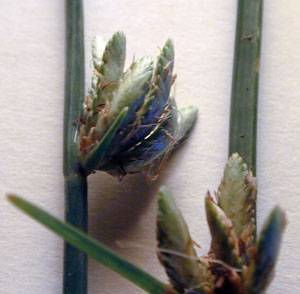
Figure 32B (above). Makaloa plant at Makalawena.
Figure 32C (right). Close-up of the spikelets of Makaloa. Note vertical bracts that appear as extentions of the culm
Consider somewhat similar Schoenoplectus spp.
|
|
~~~~ ~~~~~~~~~~~~~~~~~~~~~~~~~
|
|
23a
|
( 17 17
&
19)
|
Spikelets arranged in compact, globose heads, typically rather dense (see Fig. 32A); the culm terminating in one to several such heads, heads on rays or sessile .. .
| |
[24] |
|
23b
|
|
Spikelets arranged otherwise: spikelets in compact clusters, but these NOT globose or oval in shape, typically elongated; OR spikelets generally in clusters of but a few or spaced out along a visible supporting stem (rachis), multiple such stems present and these may be branching and jointed .. .
|
|
[29] |
|
~~~~ ~~~~~~~~~~~~~~~~~~~~~~~~~
|
|
24a
|
(23)
|
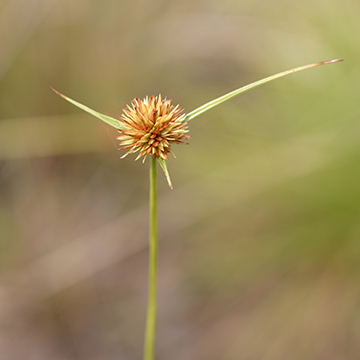 Globose to ovoid heads terminal on culm, with or without several more on rays. Subterete spikelets of two to four florets, 4-8 mm long. Leafy bracts subtending the inflorescence present or absent. { In Hawai‘i, found in somewhat drier areas. [HAW - NAT] [?GUM - NAT]
Globose to ovoid heads terminal on culm, with or without several more on rays. Subterete spikelets of two to four florets, 4-8 mm long. Leafy bracts subtending the inflorescence present or absent. { In Hawai‘i, found in somewhat drier areas. [HAW - NAT] [?GUM - NAT]
|
|
|
|
24b
|
(23)
|
Each spikelet of many (6 or more), closely imbricate florets. Leafy bracts typically present .. .
|
|
[25] |
|
~~~~ ~~~~~~~~~~~~~~~~~~~~~~~~~
|
|
25a
|
(24)
|
Spikelets longer than 6 mm (1/4 in), with 6 to as many as 40 flowers on each .. .
|
|
[26] |
|
25b
|
|
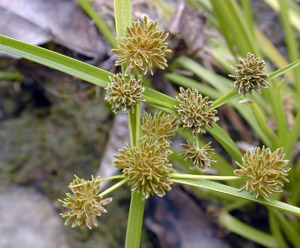 Culms 20 to 60 cm tall, sharply trigonal. Spikelets with from 8 to 28 flowers and under 6 mm in length. Spikelets arranged in compact heads, sessile or on rays to 1 cm long. Involucral bracts 2-4, up to 22 cm (9 in) long. Floral bracts (glumes) purple with green margins. ( Common in lowland wetlands [HAW - NAT] [GUM - NAT] [OBL] Culms 20 to 60 cm tall, sharply trigonal. Spikelets with from 8 to 28 flowers and under 6 mm in length. Spikelets arranged in compact heads, sessile or on rays to 1 cm long. Involucral bracts 2-4, up to 22 cm (9 in) long. Floral bracts (glumes) purple with green margins. ( Common in lowland wetlands [HAW - NAT] [GUM - NAT] [OBL]
|
|
|
~~~~ ~~~~~~~~~~~~~~~~~~~~~~~~~
[NOTE: THREE CHOICES HERE]
|
|
26a
|
(25)
|
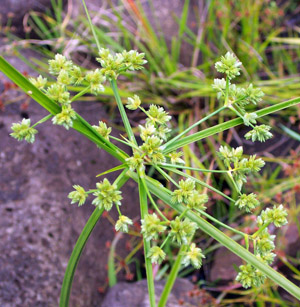 Plants between 30 and 90 cm tall. Spikelets in congested globose heads of stacked spikelets; oblong spikelets 6-12 flowered and 5 to 20 mm long, yellowish green to reddish brown. Nut on a short stalk, ellipsoid, and dark brown or black in color. { Hamakua (Hawai‘i Isl.) and possibly Kaua‘i only. [HAW - NAT] [OBL]
|
|
|
26b
|
|
Plant 20 to 60 cm high. Oblong elliptic spikelets 6 to 18 mm long and 2 to 2.6 mm wide, with 6 to 32 flowers, glumes dark purple to brownish black. Nut on a short stalk, laterally compressed, and dark brown in color. { Hamakua area of Hawai‘i Isl. only. Bloodscale sedge [HAW - NAT] [FACW] Cyperus sanguinolentus Vahl.
|
|
26c
|
|
Spikelets yellowish green to reddish brown, the spikelets not in groupings that appear stacked. Nut yellowish, compressed or not. Height usually under 0.5 m .. .
|
|
[27] |
|
~~~~ ~~~~~~~~~~~~~~~~~~~~~~~~~
|
|
27a
|
(26)
|
 Leaves shorter (or sometimes) longer than culm, flat, weakly folded, 1/8 in or less (1.5-3.0 mm) in width. Floral bracts (glumes) not awned. Nut laterally compressed, elliptic in cross-section. Lanceolate spikelets crowded with 8 to 40 flowers, spikelet tips acute. Common in and out of wetlands. C. polystachyos .. . Leaves shorter (or sometimes) longer than culm, flat, weakly folded, 1/8 in or less (1.5-3.0 mm) in width. Floral bracts (glumes) not awned. Nut laterally compressed, elliptic in cross-section. Lanceolate spikelets crowded with 8 to 40 flowers, spikelet tips acute. Common in and out of wetlands. C. polystachyos .. .
|
|
[28] |
|
27b
|
|
Leaves longer than culm, stiff, narrow, u-shaped in cross-section (channeled), about 1/8 in (2.5-3.5 mm) wide. Each glume terminating in a very short awn or recurved mucro and having membranous wings (Fig. 32H). Nut trigonous (three-sided in cross-section). { Rare, found typically at edges of wetlands and only on main Hawaiian Islands north of Lana‘i. Pu‘uka‘a. [HAW - END] [FACW][E] Cyperus trachysanthos Hook. and Arnott
|
|
|
~~~~ ~~~~~~~~~~~~~~~~~~~~~~~~~
|
|
28a
|
(27)
|
Yellowish-brown flower heads somewhat lax, with 8 - 26 flowers. { basal leaf blades sometimes exceeding the inflorescence [HAW - IND] [GUM - IND] [FACW]Cyperus polystachyos holosericeus (Link) Koyama
|
|
|
28b
|
|
Flower heads compact and globose, pale to deep reddish-brown in color and with 10 to 40 flowers per spikelet (see Fig. 30A). [HAW - IND] [GUM - IND] [FACW]Cyperus polystachyos polystachyos Rottb.
|
|
|
~~~~ ~~~~~~~~~~~~~~~~~~~~~~~~~
[NOTE: THREE CHOICES HERE]
|
|
29a
|
(23)
|
Spikelets arranged in open digitate clusters, sessile or at the ends of primary and, if present, secondary branches .. .
|
|
[30] |
|
29b
|
|
Flattened or somewhat rounded spikelets arranged more or less loosely around and up the length of primary and secondary branches terminal on the culm; spikelet stem jointed and breaking apart at maturity (Species treated by some in the genus, Mariscus) .. .
|
|
[38] |
|
29c
|
|
Spikelets in elongated, dense sessile (or on short branches) spikes clustered at the top of the culm. Involucral bracts 2-6, exceeding spikes in length. Spikelets with few florets (less than 4) .. .
|
|
[36] |
|
~~~~ ~~~~~~~~~~~~~~~~~~~~~~~~~
|
|
30a
|
(29) |
Spikelets dark reddish brown and arranged both digitally at the end of branches and spicately along some branches; each spikelet 1 to 3 cm (1/2 to 1 in) long. Rhizomes thin with globose-ovoid tubers (underground "nuts"). { Common weed in lawns and waste places. Nut grass, kili‘o‘opu. [HAW - NAT] [GUM - NAT] [FACU]
|
|
|
30b
|
|
Involucral bracts short and broad. Spikelets light brown and aranged in loose digitate clusters located at the ends of primary and secondary branches; variable in length, each spikelet 1/4 to 1/2 in (5 to 15 mm) long. { Found in wet places. Dwarf papyrus sedge. [HAW - NAT] [FACW]
|
|
~~~~ ~~~~~~~~~~~~~~~~~~~~~~~~~
|
|
32a
|
(29) |
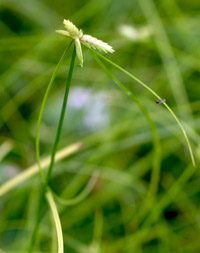 Small sedge with filiform leaf blades (thin, thread-like, 1 mm wide or less) and arching, no more than 15 cm (6 or 7 in) long, typically somewhat less, 3 or 4 arising at the base of a somewhat lax flowering culm. Spikes 2 to 6 attached together (digitate) directly at top of culm, subtended by two or more long, filiform involucral bracts. { growing in moist, shaded areas; a lawn weed, spreading by plantlets. McCoy grass, mau‘u hunehune. [HAW - NAT]
Small sedge with filiform leaf blades (thin, thread-like, 1 mm wide or less) and arching, no more than 15 cm (6 or 7 in) long, typically somewhat less, 3 or 4 arising at the base of a somewhat lax flowering culm. Spikes 2 to 6 attached together (digitate) directly at top of culm, subtended by two or more long, filiform involucral bracts. { growing in moist, shaded areas; a lawn weed, spreading by plantlets. McCoy grass, mau‘u hunehune. [HAW - NAT]
|
|
|
32b
|
|
Basal leaves not filiform, at least 2 mm wide. Spikelets mostly in loose digitate clusters at the ends of primary and secondary branches, with or without a few other spikelets sessile along some branches. Inflorescence very open with no or only a few involucral bracts, these tending to be not much longer than the flowering head. Spikelet stem not jointed .. .
|
|
[33] |
|
~~~~ ~~~~~~~~~~~~~~~~~~~~~~~~~
|
|
33a
|
(32) |
Annual or perennial herb to 0.9 m tall, with an acutely trigonous culm. Spikes tapering somewhat towards tips (that is, spikelets become shorter towards the top of the spike); Spikelets flattened, hairy, 0.6 to 1.5 cm long, not jointed, with 8-25 flowers each. { Found only on Kaua‘i. [HAW - NAT] [FACW]
|
|
|
33b
|
|
Annual or short-lived perennial herb to 1.4 m tall, with a smooth, 3-sided culm. Spikes not tapering towards tips; spikelets flattened, not hairy, 1.0 to 2.5 cm long, and jointed between the 10-25 flowers, breaking apart at maturity forming a corky, winged attachment for the fruit. { Pu‘uka‘a [HAW - IND] [GUM - IND] [FACW]
|
|
|
~~~~ ~~~~~~~~~~~~~~~~~~~~~~~~~
|
|
35a
|
(21) |
Involucral bracts under inflorescence numerous (up to twenty-two), 6 to 11 in (15-27 cm) long. Culms rising to 4 ft (1.5 m), trigonous, about 0.5 cm in diameter, with a rough surface (scabrous). Flowers 6-30 in spikelets 3-25 mm long. { An ornamental sedge, widely naturalized in streams and marshes. Umbrella sedge [HAW - NAT] [GUM - NAT] [FACW]Cyperus involucratus Roxb.
|
|
|
35b
|
|
Involucral bracts under inflorescence three to seven in number. Spikes 2 to 5 cm (1 to 2 in) in length with 6-15 spikelets, these loosely arranged to more imbricate further out on the spike. Spikelets oval, 6 mm long, yellowish with green veins; a tiny mucro at tip of the glumes. { Ricefield flatsedge [GUM - IND] [FACW]
|
|
~~~~ ~~~~~~~~~~~~~~~~~~~~~~~~~
|
|
36a
|
(29) |
Plant robust, to 1 m (3 ft) tall. Numerous dense spikes distinctly arranged on rays (1 to 16 cm long) at top of culm: a much elongated vertical spike (to about 30 mm long) is accompanied by several smaller subglobose spikes, at least two of these angled obliquely downward. Involucral bracts elongate. Spikelets 4-6 mm (to 1/4 in) long. { This species easily recognized by the form and arrangement of the spikes [GUM - NAT]
|
|
36b
|
|
Spikes either sessile or on branches, but inflorescence not as described above .. .
|
|
[37] |
|
~~~~ ~~~~~~~~~~~~~~~~~~~~~~~~~
|
|
37a
|
(36) |
Spikes clustered at the top of the culm, essentially sessile; spikes up to 1.5 cm long. Involucral bracts 2-4. Spikelets with less than 4 florets. { Tufted perennial with a short, thick rhizome. Maui County. [HAW - NAT] Cyperus aggregatus (Willd.) Endl.
|
|
37b
|
|
Inflorescence simple but spikes not sessile; instead clustered at the ends of narrow branches (rays) and 2 to 4 cm long (in some cases, much longer).
|
|
[40] |
|
~~~~ ~~~~~~~~~~~~~~~~~~~~~~~~~
|
|
38a
|
(29)
|
Spikelets with fewer than 8 flowers each, flattened or sub-terete (flattened only a little) .. .
|
|
[39] |
|
38b
|
|
Culms 40-120 cm tall, acutely trigonous, sides slightly concave. Leaves 3-5 per culm, about as long the culm. Spikes 2-6 cm long, mostly unbranched; spikelets arrayed evenly up length of rachis, each flattened spikelet with 8 to 25 flowers. Involucral bracts longer than the inflorescence, the longest 35 cm (1 ft) long. { Rare (an endangered species) in open sites in mesic forests up to 1200 m (3900 ft) elevation [HAW - END]Cyperus pennatiformis Kukenth
|
|
|
|
~~~~ ~~~~~~~~~~~~~~~~~~~~~~~~~
|
|
39a
|
(38) |
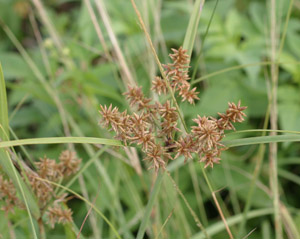 Coarse perennial with a stiff, roughened, 3-sided culm, 40-110 cm tall. Leaves numerous, most longer than culm. Spikelets flattened, to 6 mm long, with 5-7 flowers each. { Common in a range of environments from uplands to marshes. ‘ahu‘awa [HAW - IND] [GUM - IND] [FACW] Coarse perennial with a stiff, roughened, 3-sided culm, 40-110 cm tall. Leaves numerous, most longer than culm. Spikelets flattened, to 6 mm long, with 5-7 flowers each. { Common in a range of environments from uplands to marshes. ‘ahu‘awa [HAW - IND] [GUM - IND] [FACW]
|
|
|
39b
|
|
Perennial herb to 0.5 m tall (1.5 ft), with a smooth, 3-sided culm. Leaves numerous, most as long as or slightly longer than the culm. Spikelets sub-terete, to 1.0 cm long, with 3-4 flowers each. { In moist, disturbed environments on Kaua‘i and possibly O‘ahu. Meyen's sedge [HAW - NAT] [FACW]
|
|
|
~~~~ ~~~~~~~~~~~~~~~~~~~~~~~~~
|
|
40a
|
(37) |
Tufted perennial with culms to about 0.5 m tall. Leaves 10-20 cm long. Spikes cylindric, clustered on branches about equal to (or a little shorter than) the spikes; spikelets spreading at right angles to the rachis. Spikes up to 12 cm long, though typically much shorter. Involucral bracts 2-6. Spikelets 3-4 mm (1/8 in) long, with 1-3 florets (mostly 1). { Rare in Hawai‘i; known only from Lāna‘i and Kawaihae, Hawai‘i Island [HAW - NAT] [GUM - IND]Cyperus cyperoides (L.) Kuntze
|
|
40b
|
|
Tufted perennial with one or few culms, 0.2-0.7 m tall, smooth and trigonous. Leaves several, shorter than culm; sheaths pale green tinged purplish pink. Inflorescence simple, open or head-like; rays 6-10, 0-5 cm long. Spikes 5-10, each 2-2.5 cm (1 in) long, tapering to the apex. Involucral bracts 4-10, some longer than inflorescence. Spikelets 4.5 mm long, 2-3 flowered. { Plants in Hawai‘i and Guam smaller, with heads less congested than mainland Asia populations. Found in open grassy sites; in Hawai‘i reported from Kaua‘i and Moloka‘i [HAW - NAT] [GUM - IND]Cyperus cyperinus (Retz.) Suringar
|